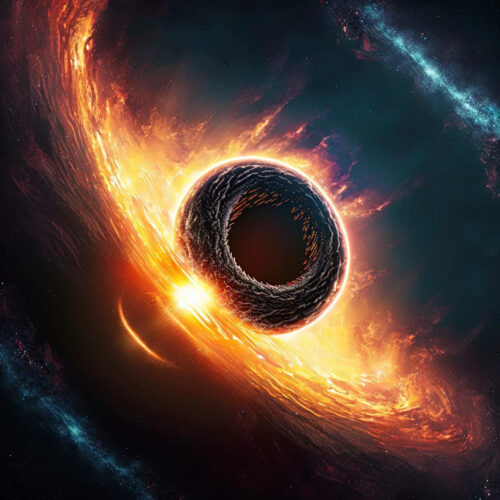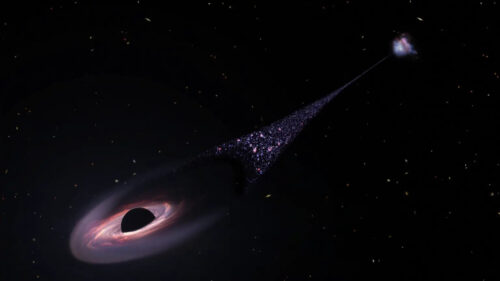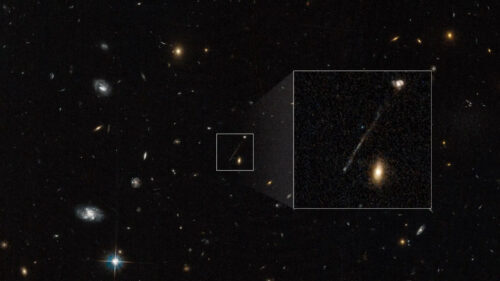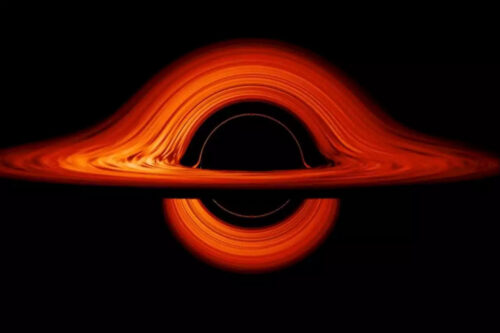
Cosmic Monster on the Loose: Runaway Supermᴀssive Black Hole Is “Not Like Anything Seen Before”
A rare and extraordinary cosmic event has captured the attention of astronomers worldwide.
In a surprising discovery, NASA’s Hubble Space Telescope accidentally stumbled upon a runaway supermᴀssive black hole hurtling through intergalactic space at astonishing speeds.
What makes this phenomenon truly unprecedented is the 200,000-light-year-long trail of newborn stars left in its wake.
This unexpected trail of star formation is believed to be the result of the black hole colliding with gas, triggering the birth of new stars.
Scientists are eager to investigate this cosmic game of galactic billiards further using advanced space telescopes like the James Webb Space Telescope and the Chandra X-ray Observatory.
A Yale astronomer named Pieter van Dokkum noticed something peculiar while examining images captured by the Hubble Space Telescope.
Initially dismissed as a scratch on the pH๏τographic film, further spectroscopy revealed that it was, in fact, a 200,000-light-year-long chain of young blue stars.
Astonishingly, this chain extended between a runaway supermᴀssive black hole and the galaxy from which it was expelled.
The black hole’s movement compresses gas along its path, causing it to condense and form stars. This unprecedented phenomenon has never been observed anywhere else in the universe.
The image provided is an artist’s impression of the runaway supermᴀssive black hole ejected from its host galaxy due to interactions with two other black holes.

As the black hole traverses intergalactic space, it compresses tenuous gas in front of it, leading to the formation of bright blue stars.
This illustration is based on observations made by the Hubble Space Telescope, showcasing the 200,000-light-year-long “contrail” of stars trailing behind the escaping black hole.
The supermᴀssive black hole currently roaming through intergalactic space is an invisible cosmic monster, moving so swiftly that it could traverse the distance between Earth and the Moon in a mere 14 minutes if it were within our solar system.
Weighing as much as 20 million Suns, this black hole has left behind an extraordinary “contrail” of newborn stars spanning a length twice that of our Milky Way galaxy.
Unlike typical black holes that consume stars in their path, this high-speed black hole plows into the gas ahead of it, stimulating the formation of new stars along a narrow corridor.
This unprecedented phenomenon was fortuitously captured by NASA’s Hubble Space Telescope.
According to Pieter van Dokkum from Yale University, the wake behind the black hole is believed to be where the gas cools and becomes conducive to star formation.
The researchers compare it to the wake left behind a ship as it travels through water.
The trail of stars resulting from this phenomenon is estimated to be nearly half as bright as the galaxy to which it is connected, indicating the presence of numerous newly formed stars.
The black hole lies at one end of the elongated structure, while the other end stretches back to its parent galaxy.
At the outermost tip of the elongated structure, there is a remarkably bright knot of ionized oxygen.
Scientists believe that the gas is likely being shocked and heated either due to the black hole’s impact or radiation emitted by the accretion disk surrounding the black hole.
The exact mechanics of this process are still not fully understood.
Pieter van Dokkum expresses his astonishment at stumbling upon this unusual phenomenon, stating that it was a serendipitous discovery.
Initially, he believed the streak observed in the Hubble image to be a linear artifact caused by a cosmic ray hitting the camera detector.
However, upon eliminating cosmic ray interference, the streak remained, indicating that it was something entirely novel and unprecedented.

To further investigate this intriguing cosmic event, van Dokkum and his team conducted follow-up spectroscopic observations using the W. M. Keck Observatories in Hawaii.
The star trail observed was described as remarkably bright and highly unusual.
This led to the conclusion that they were witnessing the aftermath of a black hole hurtling through a gas halo surrounding its host galaxy.
This runaway black hole is likely the outcome of multiple collisions involving supermᴀssive black holes.
Astronomers hypothesize that two galaxies merged around 50 million years ago, bringing together two supermᴀssive black holes at their respective centers.
These binary black holes interacted, causing chaos and instability. Eventually, one of the black holes gained momentum at the expense of the other two and was expelled from the host galaxy.
The original binary black hole may have remained intact, or the newly introduced black hole might have replaced one of the original pair, resulting in the expulsion of its companion.
As the single black hole embarked on its journey in one direction, the binary black holes veered off in the opposite direction.
Notably, a feature can be observed on the opposite side of the host galaxy, possibly indicating the presence of the runaway binary black hole.
The absence of an active black hole at the galaxy’s core supports this circumstantial evidence.

The next step for scientists involves conducting follow-up observations using NASA’s James Webb Space Telescope and the Chandra X-ray Observatory to verify the presence of the black hole.
In the future, NASA’s upcoming Nancy Grace Roman Space Telescope, with its wide-angle view and exceptional resolution, may enable the discovery of more such rare and extraordinary “star streaks” elsewhere in the universe.
Identifying these events may require the application of machine learning algorithms capable of discerning unique shapes amidst vast astronomical datasets.
The research paper detailing this extraordinary cosmic phenomenon was published in The Astrophysical Journal Letters on April 6.
